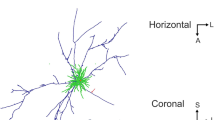Abstract
The distributions of retrograde labeled cells in fields 17 and 18 and the fields 17/18 transitional zone were studied in both hemispheres of cats after microiontophoretic administration of horseradish peroxidase into individual cortical columns in fields 17, 18, 19, and 21a. The clustered organization of the internal connections of the cortical fields, the asymmetrical locations of labeled callosal cells relative to the injected columns, and the defined distribution of labeled cells in layers A of the lateral geniculate body suggested that eye-specific neuronal connections support “binding” of the visual hemifields separately for each eye. Application of marker to columns in fields 19 or 21a demonstrated disparate inputs from fields 17 and 18 and the fields 17/18 transitional zone. It is suggested that these connections may support the extraction of loci and stereoscopic boundaries located in the central sectors of the visual space.
Similar content being viewed by others
REFERENCES
S. V. Alekseenko, S. N. Toporova, and F. N. Makarov, “Microtopography of cortical fields 17 and 18 in the cat,” Sensor. Sistemy, 13, No.4, 278–283 (1999).
S. V. Alekseenko, S. N. Toporova, and F. N. Makarov, “Neuronal connections connecting the visual hemifields,” Sensor. Sistemy, 16, No.2, 83–88 (2002).
S. V. Alekseenko, S. N. Toporova, and F. N. Makarov, “Disparate inputs of field 19 of the cat cortex detected by a horseradish peroxidase transport method,” Sensor. Sistemy, 16, No.4, 268–275 (2002).
S. V. Alekseenko, S. N. Toporova, and F. N. Makarov, “The fine structure of interhemispheric connections in areas 17, 18 of the cat,” Perception, 30, 115 (2001).
E. Bartfeld and A. Grinvald, “Relationships between orientation-preference pinwheels, cytochrome oxidase blobs, and ocular-dominance columns in primate striate cortex,” Proc. Natl. Acad. Sci. USA, 89, 11905–11909 (1992).
T. Bonhoeffer and A. Grinvald, “The layout of iso-orientation domains in area 18 of cat visual cortex: optical imaging reveals a pinwheel-like organization,” J. Neurosci., 13, No.10, 4157–4180 (1993).
B. Fischer and J. Kruger, “Disparity tuning and binocularity of single neurons in cat visual cortex, ” Exptl. Brain Res., 35, No.1, 1–8 (1979).
A. R. Harvey, “A physiological analysis of subcortical and callosal projections of area 17 and 18 of the cat,” J. Physiol. (London), 302, 507–534 (1980).
D. H. Hubel and T. N. Wiesel, “Receptive fields, binocular interaction and functional architecture in the cat’s visual cortex,” J. Physiol. (London), 160, 106–154 (1962).
D. H. Hubel and T. N. Wiesel, “Cortical and callosal connections concerned with the vertical meridian of visual fields in the cat,” J. Neurophysiol., 30, No.6, 1561–1573 (1967).
M. Hubener, D. Shoham, A. Grinvald, and T. Bonhoeffer, “Spatial relationship among three columnar systems in cat areas 17,” J. Neurosci., 17, No.23, 9270–9292 (1997).
R. Malach, “Cortical columns as devices for maximizing neuronal diversity,” TINS, 17, No.3, 101–104 (1994).
C. A. Marzi, A. Antonini, M. Di Stefano, and C. R. Legg, “Callosum-dependent binocular interactions in the lateral syprasylvan area of Siamese cats which lack binocular neurons in areas 17 and 18,” Brain Res., 197, No.1, 230–235 (1980).
M.-M. Mesulam, “Principles of horseradish peroxidase neurohistochemistry and their applications for tracing neural pathways,” in: Tracing Neural Connections with HRP, M.-M. Mesulam (ed.), J. Wiley, New York (1982), pp. 1–151.
K. Obermayer and G. G. Blasdel, “Geometry of orientation and ocular dominance columns in monkey striate cortex,” J. Neurosci., 13, No.10, 4114–4129 (1993).
J. F. Olavarria, “Non-mirror-symmetric patterns of callosal linkages in areas 17 and 18 in cat visual cortex,” J. Comp. Neurol., 366, 643–655 (1996).
J. F. Olavarria, “Callosal connections correlate preferentially with ipsilateral cortical domains in cat areas 17 and 18, and with contralateral domains in the 17/18 transition zone,” J. Comp. Neurol., 433, 437–457 (2001).
G. A. Orban, Neuronal Operations in the Visual Cortex, Springer, Berlin (1984).
B. R. Payne, “Representation of the ipsilateral visual field in the transition zone between areas 17 and 18 of the cat’s cerebral cortex,” Visual Neurosci., 4, No.3, 445–474 (1990).
P.-A. Salin and J. Bullier, “Corticocortical connections in the visual system: structure and function, ” Physiol. Rev., 75, No.1, 107–154 (1995).
D. Sanides, “The retinotopic distribution of visual callosal projections in suprasylvian visual area compared to the classical visual areas (17, 18, 19) in the cat,” Exptl. Brain Res., 33, 435–443 (1978).
J. Stone, “The naso-temporal division of the cat’s retina,” J. Comp. Neurol., 126, No.4, 585–599 (1966).
D. Y. Ts’o, R. D. Frostig, E. E. Lieke, and A. Grinvald, “Functional organization of primate visual cortex revealed by high resolution optical imaging,” Science, 249, No.4966, 417–420 (1990).
R. J. Tusa, L. A. Palmer, and A. C. Rosenquist, “Multiple cortical visual areas. Visual field topography in the cat,” in: Cortical Sensory Organization, C. N. Woolsey (ed.), Humana Press, New York (1981), Vol. 2, pp. 1–31.
M. E. Wilson, “Cortico-cortical connexions of the cat visual areas,” J. Anat., 102, 375–386 (1968).
S. Zeki and W. Fries, “A function of corpus callosum in the Siamese cat,” Proc. Roy. Soc. Lond., B207, No.1167, 249–258 (1980).
Author information
Authors and Affiliations
Additional information
Translated from Rossiiskii Fiziologicheskii Zhurnal imeni I. M. Sechenova, Vol. 89, No. 10, pp. 1281–1290, October, 2003.
Rights and permissions
About this article
Cite this article
Alekseenko, S.V., Toporova, S.N. & Makarov, F.N. Neuronal connection of the cortex and reconstruction of the visual space. Neurosci Behav Physiol 35, 435–442 (2005). https://doi.org/10.1007/s11055-005-0044-y
Received:
Revised:
Issue Date:
DOI: https://doi.org/10.1007/s11055-005-0044-y



